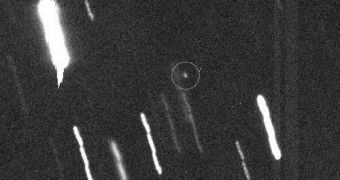Recently, astronomers from the Russian Federation released a report arguing that the large asteroid Apophis will strike our planet in 2036. Now, experts at NASA have taken stage to refute those claims.
The American space agency decided to get involved in this controversy because the claims that were made are very frightening to some, and may induce panic in the populace. A lot of ink was spilled over the Russian paper, and many took it more seriously than they should have.
While it's true that Apophis does have a chance of hitting Earth in 2036, it's also worth mentioning that that chance is tremendously small. If it were to materialize, than it would truly be a mathematical miracle, NASA investigators explains.
The asteroid will pass by our planet twice in the near future, once in 2029 and then again in 2036. The object will remain distant from us at all times, and only a gravitational anomaly could take it of its current path.
Apophis caused a lot of panic in 2004 as well, the year of its discovery. It was then calculated that the near-Earth object (NEO) had a 2.7 percent chance of impacting the Earth surface, which is a lot.
But astronomers then quickly got to working, crunching numbers, analyzing trajectory characteristics, and then producing models to predict the space rock's orbit. After this effort, it was determined that the object's chances of hitting us were slightly above zero.
“Technically, they’re correct [the Russians], there is a chance in 2036 [that Apophis will impact Earth],” explains the head of the NASA Near-Earth Object Program Office, Donald Yeomans.
But the expert adds that that chance is just 1-in-250,000. He explains that the reason the Russian team's calculation yielded a higher impact chance is that the astronomers based their models on the asteroid traveling through a gravitational keyhole.
This is an astronomical concept referring to a very small and precise region of space around Earth, slightly larger than Apophis itself, where our planet's gravity is strong enough to modify the space rock's trajectory. The fact that the asteroid will pass through this area of space is not proven.
The NEO is about 900 feet (270 meters), just about the length of two football fields. If it hits Earth, we could be faced with an extinction event the size of the one that wiped out the dinosaurs.
“The situation is that in 2029, April 13, [Apophis] flies very close to the Earth, within five Earth radii, so that will be quite an event, but we’ve already ruled out the possibility of it hitting at that time,” Yeomans explains.
“On the other hand, if it goes through what we call a keyhole during that close Earth approach […] then it will indeed be perturbed just right so that it will come back and smack Earth on April 13, 2036,” the expert adds, saying that the chances of that happening are tremendously small.
When Apophis moves closer to Earth, in late 2012/early 2013, NASA will investigate it closer, and determine its orbital characteristics, Space reports. If any danger exists, the agency will build the necessary machines to modify the asteroid's flight path.

 14 DAY TRIAL //
14 DAY TRIAL //